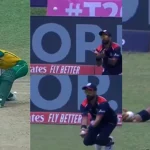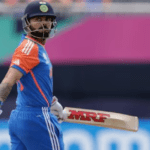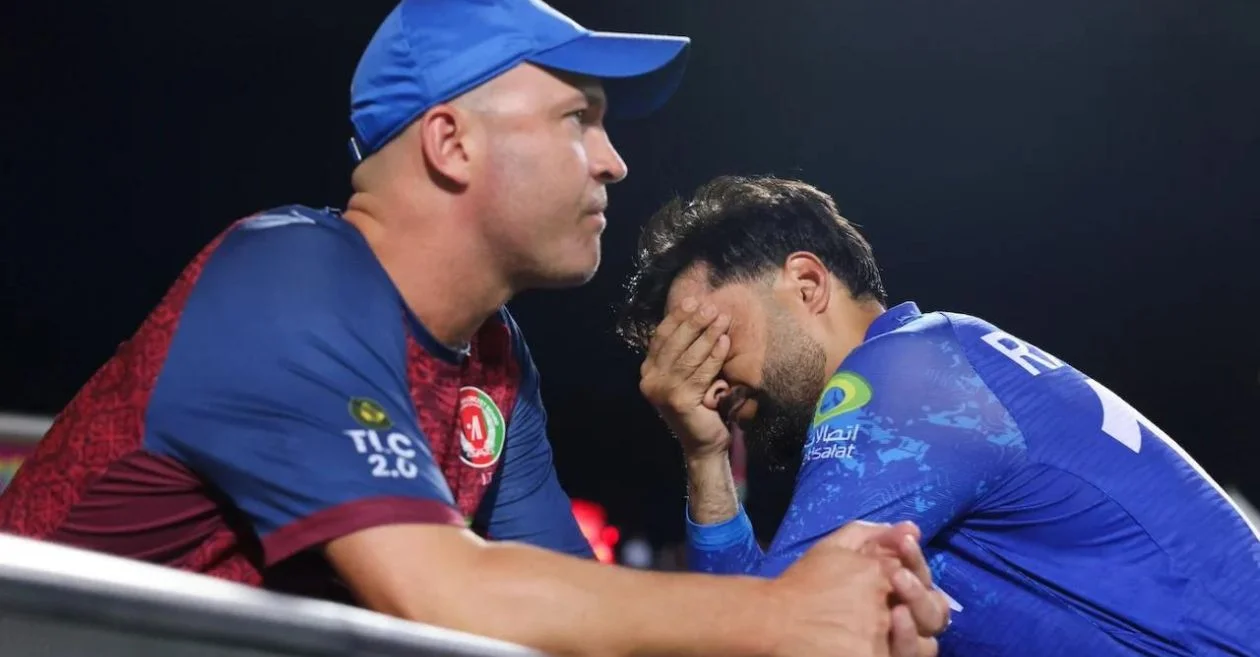Afghanistan’s journey in the T20 World Cup 2024 came to a disappointing end in the semi-final against South Africa, and head coach Jonathan Trott did not hold back in criticizing the pitch at the Brian Lara Stadium in Trinidad. The uneven wicket played a significant role in Afghanistan’s nine-wicket defeat, raising questions about pitch standards in crucial matches.
Afghanistan’s Batting Woes on an Uneven Wicket
Winning the toss and opting to bat first, Afghanistan hoped to set a challenging target. However, their plans were derailed by the unpredictable pitch conditions. The Brian Lara Stadium surface exhibited uneven bounce and lateral seam movement, which made scoring runs a daunting task. Afghanistan’s batters struggled to find any rhythm, and their innings quickly unraveled.
The challenging conditions resulted in Afghanistan being bowled out for just 56 runs, marking the lowest total ever recorded in a T20 World Cup semi-final. The Afghan batting lineup, known for its aggressive style, was rendered ineffective as the Proteas bowlers exploited the tricky pitch to devastating effect.
South Africa’s Bowlers Seize the Opportunity
South Africa’s bowlers, led by Kagiso Rabada, Marco Jansen, and Tabraiz Shamsi, capitalized on the challenging pitch conditions. Rabada and Jansen each claimed three wickets, while Shamsi provided crucial support. The uneven bounce and seam movement were utilized skillfully by the South African bowlers, who dismantled the Afghan batting order in just 12 overs.
Rabada’s pace and accuracy, combined with Jansen’s ability to extract movement from the surface, made life difficult for Afghanistan’s batters. Shamsi’s spin added another layer of difficulty, as the Afghan lineup failed to adapt to the conditions. The Proteas’ disciplined and strategic bowling display was instrumental in restricting Afghanistan to a paltry total.
South Africa Navigate Challenges to Secure Victory
Despite facing the same pitch challenges, South Africa’s batters had the advantage of chasing a very low target. With minimal pressure to score quickly, the Proteas navigated the tricky conditions with relative ease. They reached the target of 57 runs in just 8.5 overs, losing only one wicket in the process.
This victory secured South Africa’s place in their first-ever T20 World Cup final, a historic achievement for the team. The Proteas’ ability to adapt to the challenging pitch and execute their game plan effectively was a testament to their skill and composure under pressure.
Jonathan Trott’s Post-Match Critique
In his post-match press conference, Jonathan Trott did not mince words about the quality of the pitch. While he acknowledged the risk of his comments being perceived as ‘sour grapes,’ Trott emphasized the importance of a fair playing surface, especially in a high-stakes semi-final.
“I don’t want to get myself into trouble. But I also don’t want to sound a bit like ‘sour grapes’ but that’s not the pitch that you want to have a semi-final of a World Cup on. Plain and simple. It should be a fair contest,” Trott stated. His critique highlighted the imbalance created by the pitch, which he argued forced batters into survival mode rather than allowing for a competitive contest between bat and ball.
The Call for Better Pitch Standards
Trott argued that T20 cricket should offer an even contest between bat and ball, rather than forcing batters into survival mode from the start. He called for better pitch standards to ensure a balanced and competitive game, reflecting on how his bowlers might have exploited the conditions had they bowled first.
“If the opposition bowled well and gets you into a position after bowling well and through skill, then it’s fine to them. Then it’s about adapting. If we had bowled the way South Africa had, you could have seen a different second half,” the 43-year-old added. His comments underscored the importance of consistency and fairness in pitch preparation, especially in crucial matches like World Cup semi-finals.
Ensuring Fair Play in T20 Cricket
Trott concluded by emphasizing that T20 cricket is about attacking, scoring runs, and taking wickets, not merely surviving. “I’m not saying it should be completely flat with no spin and seam movement, you shouldn’t have batters worrying about moving forward and having the ball fly over their head. You should be confident in getting through the line or use their skills. And T20 is all about attacking and scoring runs and taking wickets. Not looking to survive,” Trott concluded.
His remarks echoed a broader sentiment in the cricketing community about the need for pitches that provide an even contest and enhance the quality of the game. As the T20 format continues to grow in popularity, ensuring fair play through consistent pitch standards will be crucial for maintaining the integrity and excitement of the sport.
A Lesson for Future Tournaments
Afghanistan’s defeat and the subsequent critique by Jonathan Trott serve as a reminder of the critical role that pitch conditions play in cricket. For future tournaments, especially at the highest levels, ensuring fair and balanced pitches will be essential for the sport’s integrity. Trott’s comments, while controversial, highlight an important aspect of cricket that needs attention to ensure that every match is a true contest between bat and ball. As the cricketing world moves forward, lessons from such incidents will hopefully lead to better standards and more competitive cricket.
Please check for information on the best betting sites in India – https://selectory.org/best-betting-sites/
Related posts:
 T20 World Cup: Cricket experts erupts over dead-ball rule after Bangladesh lose to South Africa
T20 World Cup: Cricket experts erupts over dead-ball rule after Bangladesh lose to South Africa
 T20 World Cup 2024: Mitchell Marsh names the ‘most important player’ in the Australian team
T20 World Cup 2024: Mitchell Marsh names the ‘most important player’ in the Australian team
 USA’s Indian-origin players express the special feeling of facing India in T20 World Cup 2024
USA’s Indian-origin players express the special feeling of facing India in T20 World Cup 2024
 T20 World Cup 2024: England registers a record win over Oman; keeps Super 8 stage hopes alive
T20 World Cup 2024: England registers a record win over Oman; keeps Super 8 stage hopes alive
 T20 World Cup 2024: Rashid Khan names the ‘superstar’ in the Afghanistan team
T20 World Cup 2024: Rashid Khan names the ‘superstar’ in the Afghanistan team
 ‘Qualified for Karachi airport’: Fans brutally roast Babar Azam’s Pakistan after their elimination from T20 World Cup 2024
‘Qualified for Karachi airport’: Fans brutally roast Babar Azam’s Pakistan after their elimination from T20 World Cup 2024
 Andy Flower names Pakistan’s next captain following early exit from T20 World Cup 2024
Andy Flower names Pakistan’s next captain following early exit from T20 World Cup 2024
 Babar Azam opens up on Pakistan’s early exit from T20 World Cup 2024
Babar Azam opens up on Pakistan’s early exit from T20 World Cup 2024
 T20 World Cup 2024 Super 8: Broadcast, Live Streaming details: When and where to watch in India, USA, Australia, UK, West Indies and other countries
T20 World Cup 2024 Super 8: Broadcast, Live Streaming details: When and where to watch in India, USA, Australia, UK, West Indies and other countries
 ICC T20I Rankings: Marcus Stoinis dethrones Mohammad Nabi to acquire top spot, Hardik Pandya shows gain
ICC T20I Rankings: Marcus Stoinis dethrones Mohammad Nabi to acquire top spot, Hardik Pandya shows gain
 AUS vs BAN, T20 World Cup 2024: Match Prediction, Dream11 Team, Fantasy Tips & Pitch Report | Australia vs Bangladesh
AUS vs BAN, T20 World Cup 2024: Match Prediction, Dream11 Team, Fantasy Tips & Pitch Report | Australia vs Bangladesh
 Ali Khan takes a screamer to dismiss Aiden Markram in USA vs SA game at T20 World Cup 2024
Ali Khan takes a screamer to dismiss Aiden Markram in USA vs SA game at T20 World Cup 2024
 Ex-Pakistan cricketer Mohammad Hafeez reiterates his stance on calling Virat Kohli ‘selfish’ during ODI World Cup 2023
Ex-Pakistan cricketer Mohammad Hafeez reiterates his stance on calling Virat Kohli ‘selfish’ during ODI World Cup 2023
 Australia pacer Pat Cummins picks up a hat-trick against Bangladesh | T20 World Cup 2024
Australia pacer Pat Cummins picks up a hat-trick against Bangladesh | T20 World Cup 2024
 Mark Wood, Jos Buttler confront umpire passionately after DRS decision saves Quinton de Kock in ENG vs SA game | T20 World Cup 2024
Mark Wood, Jos Buttler confront umpire passionately after DRS decision saves Quinton de Kock in ENG vs SA game | T20 World Cup 2024
